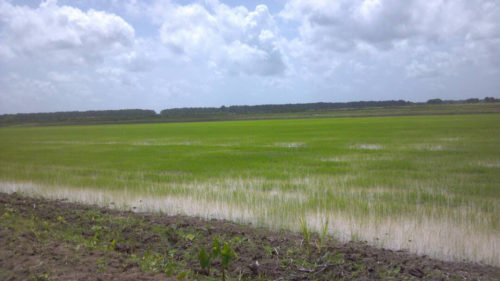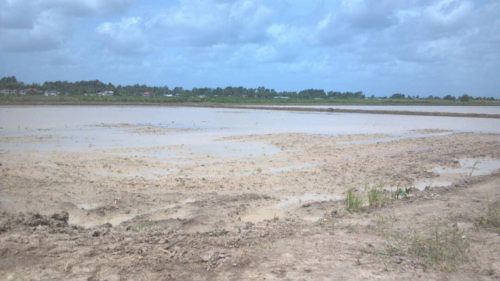With sugar production out of existence at the Wales estate on the West Bank of Demerara, government is moving ahead with its seed paddy cultivation and has completed 185 hectares of land out of the proposed 200.
Reports are that the remaining 15 hectares have to be ploughed at Vive-La-Force ‘A’ but the work has been put on hold due to the inclement weather.
Stabroek News was told that some of the rice was cultivated three weeks ago at Catherina 11-16 while another portion was sown last weekend at Vive-La-Force ‘A.’
A source told Stabroek News that no worker from the Guyana Sugar Corporation (GuySuCo) “took part in the process.”
He said that the workers were brought from Burma, Mahaicony but left after the planting was completed. However, he said, about 60 GuySuCo employees are currently tending to the cultivation.

Following the announcement in January 2016 of the closure of the Wales estate at December 2016, government had said that it would engage in diversification ventures on the sugar fields.
In July 2016, GuySuCo’s Finance Director, Paul Bhim had said that a feasibility study was being done for aquaculture and that it would hopefully be completed by the beginning of October.
He had said too that feasibility studies, which would have been completed this year, would be carried out for aquaculture, cattle, milk and dairy production.
At the time too, he said the corporation was also be looking at rice and several other crops.
But in September last year, GuySuCo published an invitation for bids in the Guyana Chronicle, for the clearing of 484 acres (200 hectares) of land.

The advertisement said that the land was “required to be cleared of all vegetation to facilitate laser land leveling for rice cultivation.”
According to the source, the engine for one of the laser machines has already been damaged and another engine was brought from one of the estates in Berbice to replace it.
Observers are not too optimistic about the government’s venture into rice cultivation, which has seen a decrease over the past two years.
Farmers have complained that they have not been benefiting from the desired price for paddy to cover their high cost of production.
As such, many have opted out of the rice sector and have turned to other means of earning an income and have even migrated.
Critics have also said that GuySuCo has to look for foreign exchange earners and rice may not be a viable option as there is already a lot of competition on the market.
The rice cultivation has been undertaken through a partnership between GuySuCo and the Guyana Rice Development Board (GRDB).
The corporation had said in a release, that the GRDB 10 variety of seed paddy would be grown and the GRDB 13 Aromatic rice was being considered as another variety to be cultivated at that location.
It had promised to release further information on markets and other components relevant to the business plan.
The release had said too: “It is important to note that GuySuCo’s interest in rice is a component of an integrated commercial aquaculture production and processing project.”
It added: “Therefore seed paddy cultivation is a part of the diversification programme and is a preparatory measure to support the aquaculture project. Nearly 60% of the cost of growing fish, for example, tilapia, can be the cost of the feed; as such, the rice bran is being evaluated as an essential ingredient of the feed. Hence, the proposed rice project is not an end in itself but includes ultimately the production of bran for fish feed.”





